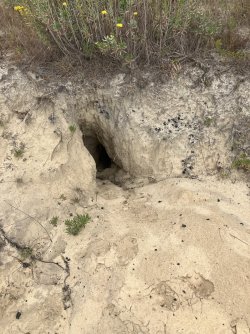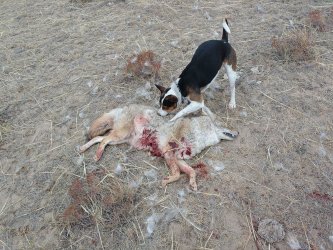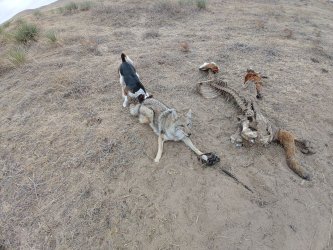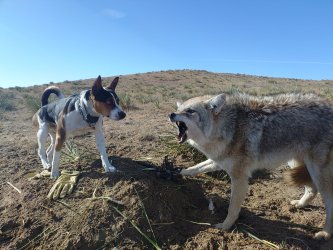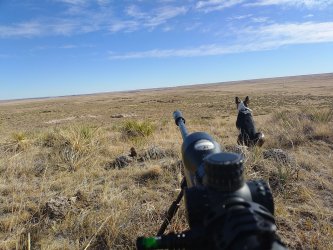Find the prey and find the predator. So many factors play into the coyote and other predator numbers. Food, water, weather conditions all are a part of why coyotes live where they do. Coyotes have four paw drive and the only time they are tied to any one area is when they have young pups but even then, they can and do move the pups when they see the need to. That is only one of the reasons that we keep track of what is going on in the world of the predator, we want to know if they have any disease's that are reducing's their numbers, is drought limiting their prays numbers, has bitter cold and deep snow killed large herbivores for them to forage on, for a limited time. We also keep track of the number of pups per litter in the spring which is actually controlled by the health of the females. And that is controlled by food, water, weather, disease, and a lot of other environmental factors. These are all things that we keep track of, we keep in our notes what has been going on around us then in future years we can compare past to present and have a better idea of what, where and why the coyotes are doing what they are. Even if we don't want to kill the pups for control, we still want to know what the average litter size is for the fall hunting. We want to know what our coyote numbers will look like; we want to know where they will be when they will be there most likely. Coyotes don't always answer a siren they might come to it instead, they may have heard it too many times before, they might be too close to it, or it might take them several minutes to get to a place where they feel comfortable answering from.
-
If you are being asked to change your password, and unsure how to do it, follow these instructions. Click here
You are using an out of date browser. It may not display this or other websites correctly.
You should upgrade or use an alternative browser.
You should upgrade or use an alternative browser.
Ramblings and Such From Hunting Coyote
- Thread starter DSheetz
- Start date
 Help Support Long Range Hunting Forum
Help Support Long Range Hunting Forum
I was listed as number 18 in the state to have West Nile, before I was diagnosed with it I started seeing some dead Meadow Larks and a few black birds laying around some of the areas that I frequented. I went to my mandatory 3-day training where the state veterinarian said that we would be seeing West Nile virus in the state before the end of the year. At that time, I asked how we would first start noticing the signs it was here. Dead black birds were one of the indicators, meadow larks are included as black birds. I started showing signs latter in the year in August, I got a head ach that felt like a migraine, I had a fever that I couldn't get to come down it hurt to just touch my hair anywhere even on my arms. I visited with some of the ranchers before and mentioned that they might want to vaccinate their horses for it. After I got it and visited with one of them, he decided to vaccinate his horses a day after he did, he was out checking cattle when his horse acted up every time, he turned him with the reins touching his neck. He thought about it had him checked and sure enough he had West Nile he was sensitive to the touch the same as I had been. Another reason that we stay aware of our surroundings. I found a bat clinging to a wall once in January so I knew it was sick, I turned it in but found that it wasn't rabies as I had thought it might be, but it was white nose disease.
We are having some average weather for this time of year now. We got some snow and rain, and it has helped with the firefighting the two major fires in the state are in the eighty percent contained range. I feel better about getting out and checking the area out now that it isn't as much of a chance of catching the dried grass on fire. The ranchers in my area had a good crop of grass so their byproducts of livestock did well. I have been rereading the book that Ed recommended to me. The Colt .45 Automatic A Shop Manual, by Jerry Kuhnhausen. Like all other good reading books, I am finding more useful information. I might have to start gathering more parts for a new project. One of my wife's friends asked her if she would watch her younger kids for a few hours the other day so the two boys and I started some knives for them to give their mom, while the daughter thought she would like to bake some treats for the family and friends, it was kind of like having grandkids over. With our weather and the young of the year being out and still learning to live on their own the coyote hunting and calling is interesting now. It can be nearly as exciting as in the spring denning season with them landing almost on top of you at times, I have to get to that rabbit before the owner of this area does type of thing. Yet you will at times have a group of them running together still and can have multiples respond also, you never know what you might get.
Bucklowery
Well-Known Member
I found this den hole from this year, while at work. It was placed in a perfect spot. South facing slope up on top of a hill in an old dirt pit. There had been a coyote by recently but other than that I would guess nothing ventures by that way
Thanks
Buck
Thanks
Buck
Attachments
More than 95 percent of the dens that I have seen were south facing and high enough that even a flash flood wouldn't fill them with water. Most of them also had holes that were small reaching to the surface along their length as breather holes for ventilation, with several of the dens having a back entrance. That is a perfect example of a well-placed coyote den. Most of the coyote dens that I have been to were relatively clean not having a lot of animal parts or bones around, while the majority of the red fox dens were not very clean with animal parts, birds and snakes being brought in for the young. They could be smelled from a distance.
Gene's new dog Zip, in the first one he's pulling the fur out of one Gene called and shot, in the second one he's playing with a female that Gene trapped. Gene said that he had to loop back by this set and forty-five minutes after he had remade it, he had a male in the trap. That tells me the male was laying out in the sage brush watching Gene and Zip at the set, maybe from a couple hundred yards. Gene tells me that the only problem he has with Zip is that when he shoots a coyote Zip will have pulled large amounts of fur out of it before he can get there and ruins the pelt. Zip is around two years old now and learned a lot from Jack Gene's old Jack Russell. Jack was at least 16 years old last year. Gene replaced me when I retired, he told me one day I kind of have to like you Jack does, and he doesn't like anyone. We have had some good adventures together over the years. Jack would always tell gene when he had a flea so that Gene would stop the truck get out and comb the fleas out as Jack had an allergic reaction to flea sprays, collars or powders. I got a call one evening that a rancher had some coyotes take after her daughter-in-law and her horse and dog. I took Gene up and introduced them. The next evening Gene called me and said that was an interesting day he and Jack called in and shot 6 coyotes that morning from three stands, in the area where they had bothered the woman and her dog. Gene is one of the guys that's a lot better at control than me. One of the ranchers that I worked for told me one time you know that he's a crazy guy, but he kills a lot of coyotes. I laughed and said anyone that spends as much time as him and Jack do alone gets that way.
Attachments
Airedale56
Well-Known Member
In 1999 and 2000 I was living in Gillette. In my off time I did some predator control work on a couple of sheep operations and cattle ranches during spring lambing and calving.
I discovered that that the only thing dumber than a 14 year old girl is a newborn lamb. (You dads who raised daughters can relate to my comment)
I headed to a Lambing pasture South of the Belle Fourche River on Highway 59 . When walking to a stand, if I skirted the sheep I had to watch for the ewes to get up and walk away from their lambs as I went by and then freeze in place.
The sleeping lambs would wake up, startle at being alone and run to the nearest moving thing. If that was me, the dang things would cling so close, bleating, to my legs I could hardly walk. I couldn't run away from them. They taught ME to give the flock a wide berth on the way to a stand. I had to wait for the ewe to come back to get them. I imagine that they would do the same thing and run to a coyote or fox if one was close when they found themselves alone.
Regarding fox dens in lambing pastures, Dave's experience parallels mine.
I found a fox den and discovered a cornucopia of wildlife parts around it. An interesting thing I found in Campbell County was it seemed that every little low spot had water standing in it and a pair of ducks or geese nesting there.
I was amazed to find that the water lasted long enough for the birds to fledge and fly away.
Lamb, duck, goose, songbirds, voles and mice, even insects were on the fox menu. The fox dens I found were much messier than the coyote dens.
Foxes remind me of a cat when watching them hunt. They also remind me of whitetail deer. Upon seeing a man, running hard until they are out of sight. Rarely offering a shot to a hunter.
Coyotes and mule deer lope/stott for a distance then slow down and stop to make an evaluation of the situation, offering a shot at a standing, still target.
I discovered that that the only thing dumber than a 14 year old girl is a newborn lamb. (You dads who raised daughters can relate to my comment)
I headed to a Lambing pasture South of the Belle Fourche River on Highway 59 . When walking to a stand, if I skirted the sheep I had to watch for the ewes to get up and walk away from their lambs as I went by and then freeze in place.
The sleeping lambs would wake up, startle at being alone and run to the nearest moving thing. If that was me, the dang things would cling so close, bleating, to my legs I could hardly walk. I couldn't run away from them. They taught ME to give the flock a wide berth on the way to a stand. I had to wait for the ewe to come back to get them. I imagine that they would do the same thing and run to a coyote or fox if one was close when they found themselves alone.
Regarding fox dens in lambing pastures, Dave's experience parallels mine.
I found a fox den and discovered a cornucopia of wildlife parts around it. An interesting thing I found in Campbell County was it seemed that every little low spot had water standing in it and a pair of ducks or geese nesting there.
I was amazed to find that the water lasted long enough for the birds to fledge and fly away.
Lamb, duck, goose, songbirds, voles and mice, even insects were on the fox menu. The fox dens I found were much messier than the coyote dens.
Foxes remind me of a cat when watching them hunt. They also remind me of whitetail deer. Upon seeing a man, running hard until they are out of sight. Rarely offering a shot to a hunter.
Coyotes and mule deer lope/stott for a distance then slow down and stop to make an evaluation of the situation, offering a shot at a standing, still target.
Last edited:
Airedale56 : It has always amazed me that the birds knew which watering hole would last long enough for the hatchlings to fledge. Some very good observations, sir and you make good comparisons with the animals. Yes, I have watched lambs bounce up nose to nose with bobcats, coyotes and red fox, and most times it seemed that the predators knew what the lambs would do and took full advantage of it especially the coyotes. Observation is a skill that we should all learn and respect.
Airedale56
Well-Known Member
Thanks, Dave.
I also discovered that foxes loved to den in culverts along state highways and county roads at approaches to gates in the fences.
I saw lots of fox pups peeping out as they got bold enough to leave the dens.
I forgot to mention antelope fawn parts on the fox dens. Usually a lower leg left outside.
I also discovered that foxes loved to den in culverts along state highways and county roads at approaches to gates in the fences.
I saw lots of fox pups peeping out as they got bold enough to leave the dens.
I forgot to mention antelope fawn parts on the fox dens. Usually a lower leg left outside.
I have seen a lot of fox dens in pipes and culverts, I've turned on the irrigation pump and flushed them out several times. I also noticed that the little reds really love antelope fawns. One of the ways that I could tell if there was a fox problem with the lambs was when the lambs got old enough to run faster than the fox. and of good size, was that the lambs would start having short tails.
Gene said that Jack will be 18 this spring. Jack wakes Gene every morning ready to go check the line and go riding in the truck. Jack has his comfy bed in the truck where he spends his day sleeping just happy to be with Gene and Zip. Jack is pretty much deaf and has lost much of his sight in his right eye but still has the desire to be out there doing what he loves. Kind of like some of us, we got old but still love to do what we can. Zip, jacks new buddy, earning his room and board, teasing one in the trap and doing his part as a live decoy on the stand. Our dogs are our family, and we do for them like we would want them to do for us. They would give their lives for us and work hard to please us.
Attachments
In the picture of Zip decoying you can see the rifle set up, on the scope note the level so that the action of the rifle is true for the longer shots, you can see it with your non dominate eye if you are keeping it open and not closed while sighting, and you don't throw the bullet to the side by canting the rifle. Note the can so that it helps keep the other coyotes unaware of the exact location of the origin of the shot that just killed its buddy. Yeah, I know preaching to the choir.
DMP25-06
Well-Known Member
Dave ,
Great photo of Zip , confronting Coyote in the trap .
How would you rate the pelt of the coyote in the trap ?
DMP25-06
Great photo of Zip , confronting Coyote in the trap .
How would you rate the pelt of the coyote in the trap ?
DMP25-06
